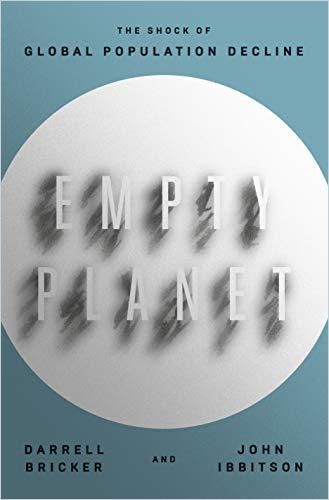Researcher Darrell Bricker and journalist John Ibbitson offer startling, evidence-based predictions regarding an ever-diminishing population and its effects.

Less of Everybody
International social researcher Darrell Bricker – chief executive officer of Ipsos Public Affairs – teams up with award-winning journalist John Ibbitson – who writes for Canada’s Globe and Mail. They bring an unexpected wrinkle to the immigration debate by arguing that developed nations must welcome immigrants to mitigate a coming population decline.
As authorities such as the United Nations warn about population explosion, Bricker and Ibbitson counter by insisting that the dwindling of humanity raises complex issues. In this data-rich and highly readable account, the authors describe the factors influencing lowered fertility and what the world will be like with fewer people.
The authors turn more than a few paradigms upside down, and reviewers welcomed their subversive, illuminating perspective. The New York Times Book Review called this, “An ambitious reimagining of our demographic future.” And The New Statesman honored the authors’ clarity and startling futurism by saying that their book, “…links hard-to-grasp global trends to the easy to-understand individual choices being made all over the world today…a gripping narrative of a world on the cusp of profound change.”
Erroneous Predictions
Before debunking it, Bricker and Ibbitson cite the conventional wisdom that runaway population growth threatens humanity and the planet. United Nations demographic forecasts, for example, suggest Earth’s population will grow from seven billion to 11 billion by the end of the century.
Population decline isn’t a good thing or a bad thing. But it is a big thing.Darrell Bricker and John Ibbitson
The authors are adamant that conventional wisdom is dead wrong: In about 30 years, they assert, the world’s population will begin to decline. Generation after generation, century after century, Bricker and Ibbitson avow, the human race will shrink.
Fits and Starts
The authors cite demographer Warren Thompson’s “Demographic Transition Model.” Its four stages portray population movement in less-civilized to more-civilized societies. Stage One cultures have high fertility and death rates. Stage Two cultures have high birth rates and declining death rates. Stage Three cultures feature falling birth and death rates, and Stage Four cultures have birth and death rates in relative equilibrium.
India, soon to become the most populous nation on Earth, will see its numbers stabilize in about a generation and then start to decline.Darrell Bricker and John Ibbitson
Bricker and Ibbitson explain that in developed countries today, birth rates are below the level that will replace a dying population. Bricker and Ibbitson argue that the trends that combine to generate smaller families include increased urbanization, greater access to education, post-World War II modernization, improved public health and governments curbing population growth.
Mitigating Population Decline
The authors present examples of countries that are trying to reverse their shrinking population by offering incentives for childbirth. Sweden, for example, grants longer parental leaves and increased child allowances. Though it seems right out of a dystopian film, Bricker and Ibbitson describe how Singapore has created a government-sponsored dating service.
The core idea that Bricker and Ibbitson offer is that advanced nations can supplement the declining population by welcoming more immigrants. They note that Canada recognizes immigration as an economic boon. The authors admire Canada’s merit-based immigration system, which seeks and admits highly educated people. Bricker and Ibbitson remind readers that the United States built its vibrant culture and economy on welcoming immigrants to America’s melting pot.
The authors share – and this may surprise some readers – that America brings in the highest number of legal immigrants per year, about one million people –though Australia and Canada bring in more immigrants as a percentage of the population. But Bricker and Ibbitson warn that immigration doesn’t offer a permanent solution to population decline: The median age of migrants is rising – it’s now 39 – and typically, the authors stress, migrants embrace the low-fertility norms of their adopted countries.
Pluses and Minuses
Bricker and Ibbitson believe that in 30 or 40 years, in a less-crowded world, most people will live in cities. They encouragingly predict that young people will face less competition for jobs.
Fewer people in the peak acquisition years, from graduation until middle age, means fewer people to purchase cars and refrigerators and sofas and jeans, so less economic growth.Darrell Bricker and John Ibbitson
The authors seem somewhat optimistic when they maintain that the natural environment will improve due to increased urbanization, and that underpopulated rural areas mean large forests will grow again as tropical rain forests and northern boreal forests increase, cleaning the air and mitigating global warming. Compared to the hard-nosed analytical thinking that makes up most of their book, this idea reads more like wishful thinking than evidence-based findings.
Startling Conclusions
The future always looks like the past until someone perceptive details how it won’t. Bricker and Ibbitson perform that service to a startling degree, writing with wit and an easy style that makes digesting their many numbers and charts a pleasure. Their arguments are well-founded, their evidence abundant and their conclusions clear. Basically, they say, there will be fewer humans in the future, those who remain will be increasingly dependent on one another, and the wisest course will be to try to get along. They argue convincingly that xenophobic developed nations will face inevitable economic decline.
The authors’ presentation of how population affects pretty much everything spurs many compelling questions. So a list of likely ancillary readings must cover myriad topics. Worthy companion volumes include The Rational Optimist by Matt Ridley, The New Climate War by Michael E. Mann, Who We Are and How We Got Here by David Reich, and Rutger Bregman’s Humankind.













